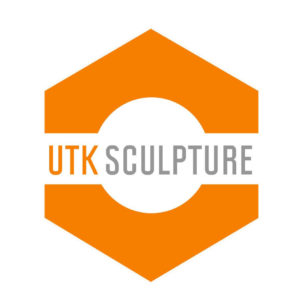INTERVIEW: JERED SPRECHER
MAR. 31, 2018
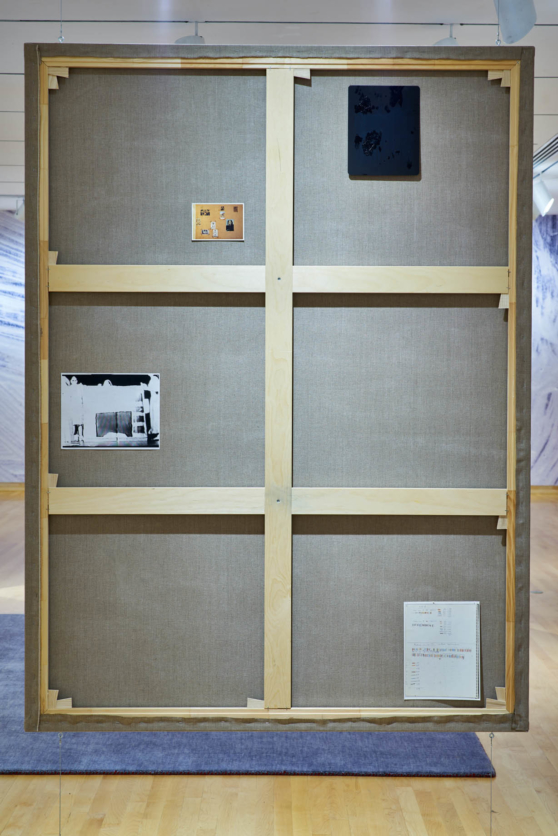
INTERVIEW: JERED SPRECHER
MAR. 31, 2018
Rachel Bubis: You describe yourself as “a hunter and gatherer of images.” Are these both digital and physical? Where do you keep them?
Jered Sprecher: Yes, both digital and physical images. A good friend of mine, who is also an artist, talks about being in the studio even when you are not physically in the studio. I really take that to heart. I am always looking for things that are engaging to the eye and the mind. I take a lot of photos with my camera and smartphone, these can be anything from a sunset, to graffiti, reflections on windows, a dying tree, if I am intrigued I want to record it with a camera or sketchbook. I am also pouring through books looking at historical and contemporary artworks. Before I recycle a magazine, I always tear out any pages with colors, shapes, or arresting images that might inform a future work. This archive is stored on my hard drive, online, in paper folders, sketchbooks, and even in stacks in my studio. I am constantly going back through these folders and images, looking.
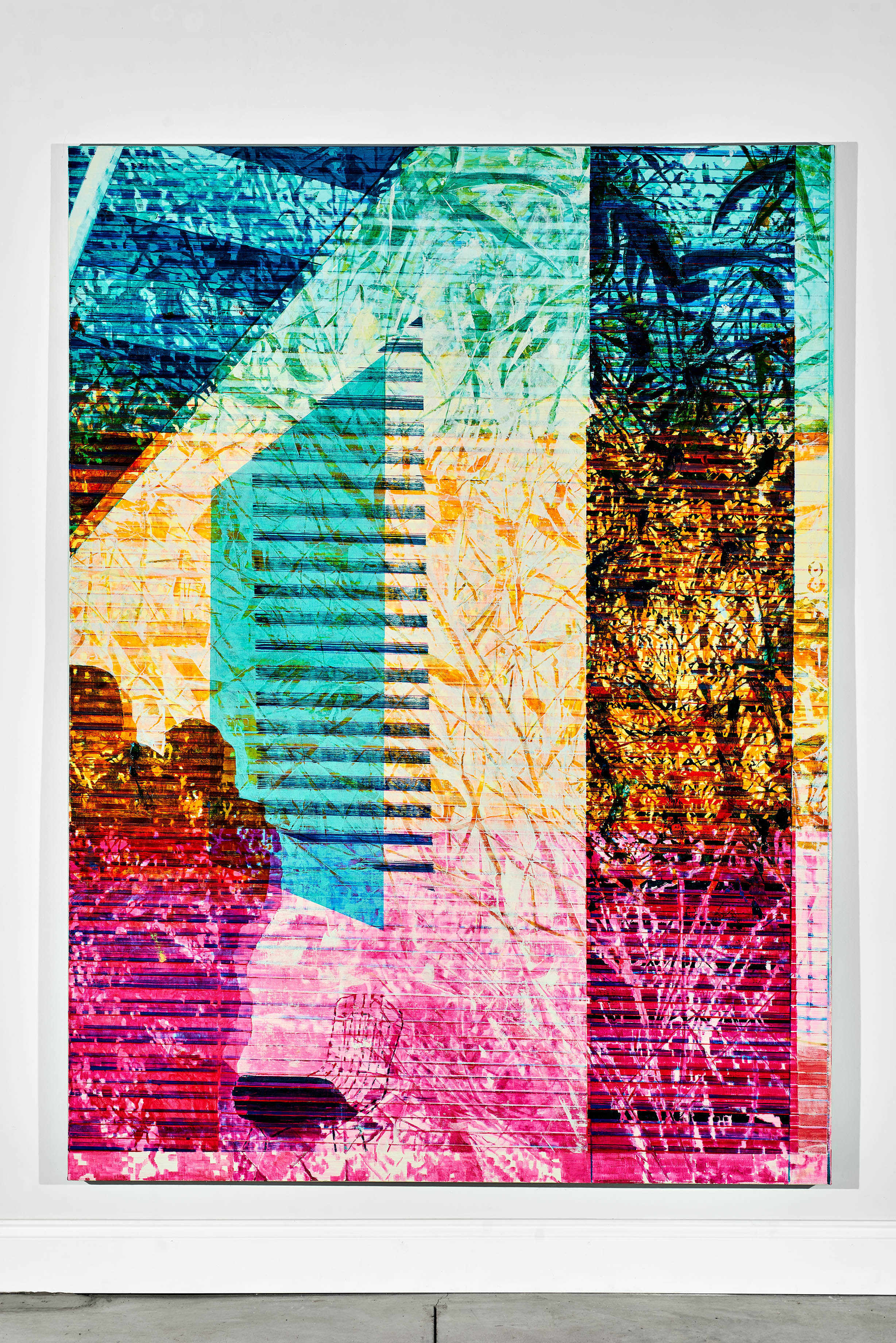
Jered Sprecher, 8.25 Minutes (detail), six oil on linen paintings, wool rug, drawings on paper, various printed images on paper, and hanging hardware, Approximate Dimensions: 20’ x 16’ x 10’, 2017. (Courtesy of Artist)
RB: Do you make collages or keep a sketchbook?
JS: My drawing practice really comes out the archive that I mentioned. I keep a sketchbook that has lots of notes in it as well as collages, drawings, and other found images. There is a part of my studio that is just dedicated to drawing and collage. It is the messiest part of my studio. It is really where the ideas for larger works are born. I would be happy spending all my time there. Drawing is home and has always been home, wherever I am.
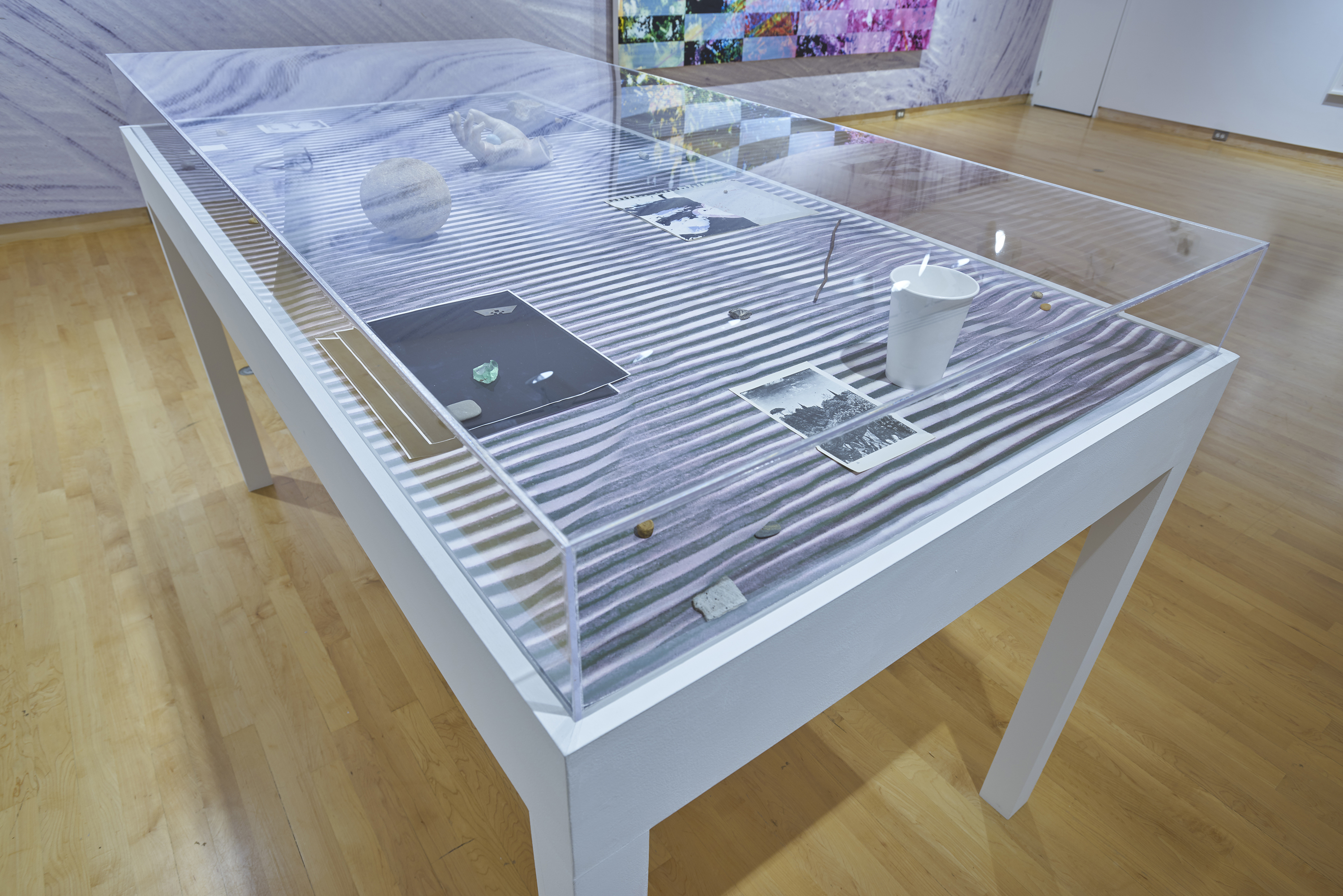
Jered Sprecher, Bed, tabletop installation including digital prints on canvas, Xerox copies, drawings, pages torn from books, stones, fossils, manikin hand, robins egg, copper wire, broken glass, metal vice, and a paper cup, Approximate Dimensions: 72” long x 30” wide x 40” tall, 2017. (Courtesy of Artist)
RB: Do you have a specific plan set forth before you make a piece or do you make choices in the moment?
JS: Each piece has a starting point, a genesis from which it begins, however I never know what the final painting will look like. I want the painting to reveal itself to me over time. There is often an image or images that I refer to as the painting begins. After working on the painting, I have to set those aside and let the painting follow its own path. It is important for me that the painting never feels completely locked down. I want a certain feeling of contingency present in the work.
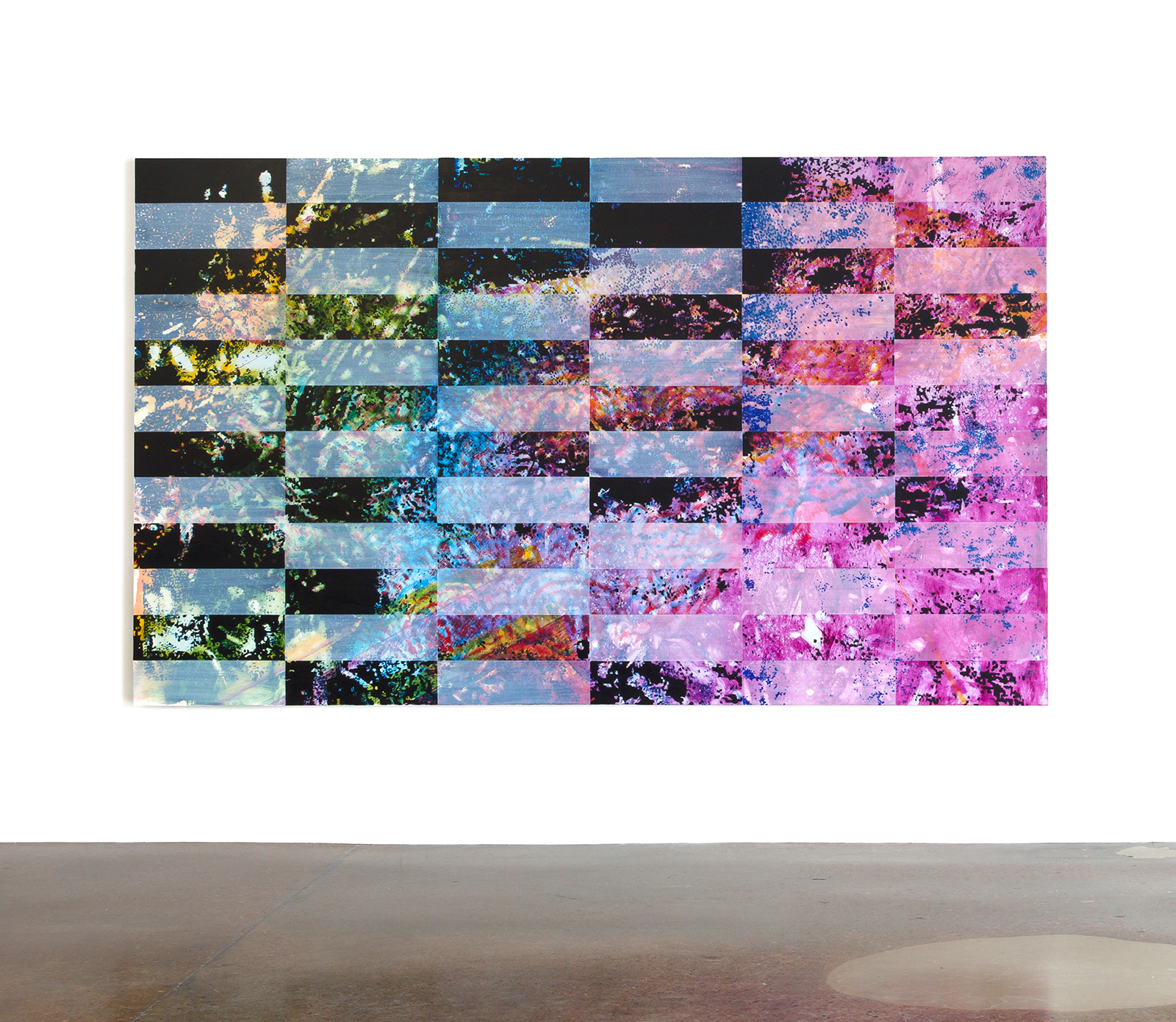
Jered Sprecher, Respiro, oil on canvas, 72” x 120", 2015. (Courtesy of Artist and Zeitgeist Gallery)
RB: What draws you to the medium of painting and drawing over other media?
JS: As humans, we make images. It is important for me to wade into that river, that history, and make images that are in communion with what has come before and what comes after. I love that painting and drawing have this long deep history across continents. Painting and drawing also easily integrate new technology, which they have been doing since the beginning. Finally, they are both so dependent on the perspective and touch of the maker, as if the artist’s DNA is embedded in each painting or drawing that they make.

Jered Sprecher, 8.25 Minutes, six oil on linen paintings, wool rug, drawings on paper, various printed images on paper, and hanging hardware, Approximate Dimensions: 20’ x 16’ x 10’, 2017. (Courtesy of Artist)
RB: There are a lot of layers in your work. I see them both physically (as in layers of paint), but you also seem interested in virtual layers of space that we experience through technology. What do you hope to achieve by smashing these layers into one plane? Where does this desire come from?
JS: I remember reading an account of how ancient cave paintings would have been experienced. There would be the animal or other image painted on the stone surface, the dance of light from an open fire, and the shadows of people moving around the cave. This flickering type of image, is much more emphatic, than the documentary photos of cave paintings. I find myself wanting to make images that flicker, that have veils, windows that can be dragged and dropped. The layers are really layers of experience, layers of knowing and not knowing. I imagine the images to be like being lost in a forest, either the trees seem like a disorienting wall or they open up to show the path through.
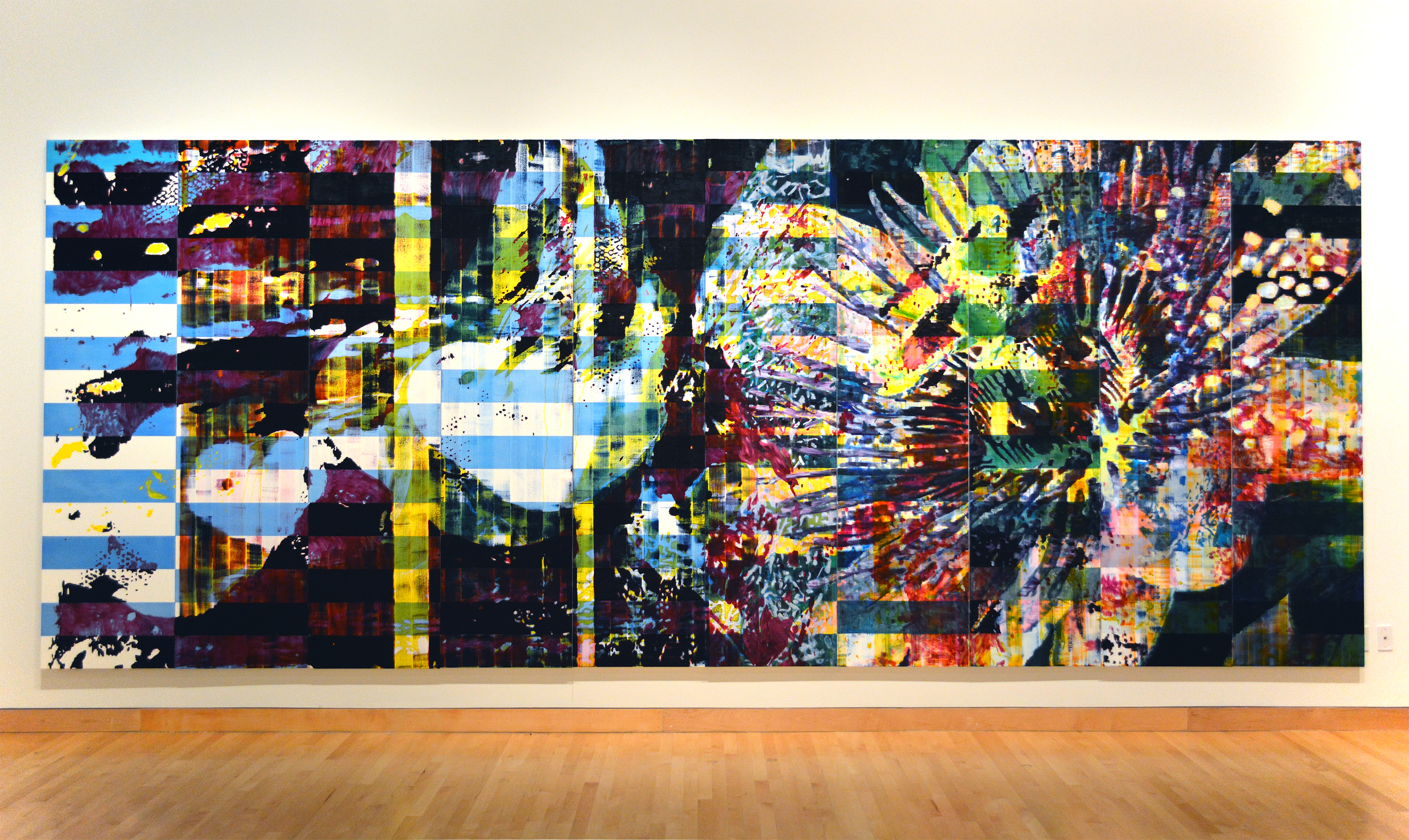
Jered Sprecher, A Plane is a Pocket in the Corners of the Mind, 96” x 240”, oil on canvas, 2014. (Courtesy of Artist)
RB: In an ideal world, what would be the ultimate effect of your work?
JS: I know that people engage art in different ways. I want the experience to be a thinking and feeling experience. The formal presence of the work is provocative and hooks the viewer, from there the work should reveal itself over time. Recently a friend described my work as apocalyptic… I might just be OK with that. Wonder and dread at the revealing.

Jered Sprecher, 8.25 Minutes (detail), six oil on linen paintings, wool rug, drawings on paper, various printed images on paper, and hanging hardware, Approximate Dimensions: 20’ x 16’ x 10’, 2017. (Courtesy of Artist)
RB: You’ve talked about being entranced by your computer or phone screen, which is something I think we can all relate to. Do you think this is a bad thing? If so, do you try to monitor this for yourself? I believe I read that you equate the feeling of staring into a computer screen to staring into a fire. Can you elaborate? (Why are these similar, what do you find interesting about this?)
JS: As humans we like to stare at things that emanate light. Moon, fire, smartphone, stars, movie screens, a firefly, and glowing embers are all things we gaze upon. We can easily loose track of time staring at a fire or staring at a screen transfixed. I think that the prevalence of screens is changing how we relate to the world and others. Perhaps it is the consuming quality of light that draws us in, the question is just how close do we get to the flames? Like anything in excess, there are diminishing returns and adverse effects. I like my technology, but I feel and see how it shifts our relationships.

Jered Sprecher, 8.25 Minutes, six oil on linen paintings, wool rug, drawings on paper, various printed images on paper, and hanging hardware, Approximate Dimensions: 20’ x 16’ x 10’, 2017. (Courtesy of Artist)
RB: Does the physical landscape and/or culture of Knoxville (or TN) inspire your work at all?
JS: I think so. I love visiting places to see how the environment and the people who live there have shaped the place over time. I grew up in the Midwest, spending time in Kansas, Nebraska, and Iowa. There, one is aware of the open expanse of the sky, looking out toward open vistas on the horizon. I lived in New York City before moving to Knoxville. In New York, the city has not only expanded out, it has grown down into the earth as well as up into the sky. In that matrix, there is an incredible tapestry of people living together. When I first moved to Knoxville, I was most struck by the topography of ridges and hollows and how green it is during three out of the four seasons. There is a strong sense of nature always ready to reclaim buildings and space that have been built and designed by human hands. Strangely enough, East Tennessee was the most disorienting landscape I had encountered. In New York City or Kansas, so many streets are laid out on the grid. In East Tennessee the topography dictates a design of city layout based off of rivers and ridges and dramatic changes in elevation. I think I can safely say that the grid held a larger sway over my work in the past. Now something else is taking over.
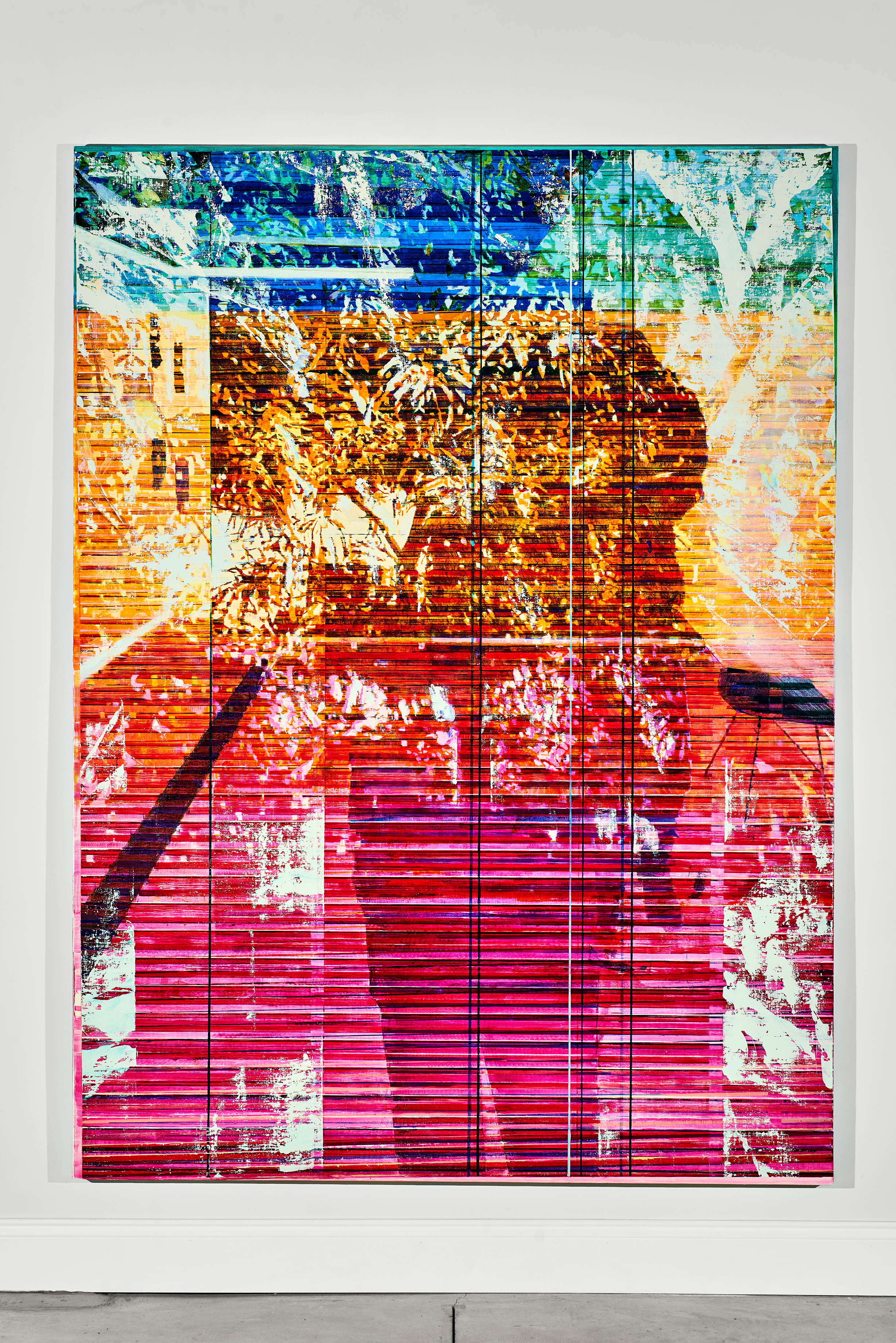
Jered Sprecher, 8.25 Minutes (detail), six oil on linen paintings, wool rug, drawings on paper, various printed images on paper, and hanging hardware, Approximate Dimensions: 20’ x 16’ x 10’, 2017. (Courtesy of Artist)
RB: What are you working on now and what’s next?
JS: I just returned from installing the work 8.25 Minutes at the Nerman Museum of Contemporary Art in Kansas City. 8.25 Minutes is an installation of six paintings hanging vertically from the ceiling to form a room within the gallery. From outside the installation you see the stretcher bars and backsides of the linen canvases, with small drawings and photocopies attached to the linen. As one moves inside the installation, stepping onto a blue-grey carpet, the six paintings reveal imagery evocative of reflections within a glass house, seeing both inside and outside simultaneously. I completed this work in 2017, and first showed it at the Knoxville Museum of Art.
Right now, I am preparing for three upcoming shows. I will be showing some larger paintings in a two-person show at Zeitgeist in Nashville later this spring. This July, I have a one-person exhibition at Jeff Bailey Gallery in Hudson, New York. I am in the midst of wrapping up a new series of paintings for that show. There are lots of new twists and turns in this body of work. In November, I will have a show at Gallery 16 in San Francisco. All this has me eagerly anticipating every moment I can get in the studio.
Jered Sprecher was born in Lincoln, Nebraska (1976). He received his MFA from The University of Iowa and his BA from Concordia University. He has had solo exhibitions at Jeff Bailey Gallery in New York, Gallery 16 in San Francisco, Stephen Zevitas Gallery in Boston, and Kinkead Contemporary in Los Angeles. His work has been exhibited at The Drawing Center, Brooklyn Academy of Music, Urban Institute for Contemporary Art, Chinati Foundation, Irish Museum of Modern Art, Nerman Museum of Contemporary Art, Des Moines Art Center, Hunter Museum of American Art, Knoxville Museum of Art, and Espai d'art Contemporani de Castelló. In 2009, he was awarded a John Simon Guggenheim Memorial Foundation Fellowship. More recently he was the Artist-in-Residence at the Chinati Foundation in Marfa, Texas. He currently lives and works in Knoxville, Tennessee where he is a Professor at The University of Tennessee.
Rachel Bubis is an independent arts writer as well as the Exhibitions Manager of Seed Space in Nashville, TN.
* all images courtesy of the artist


